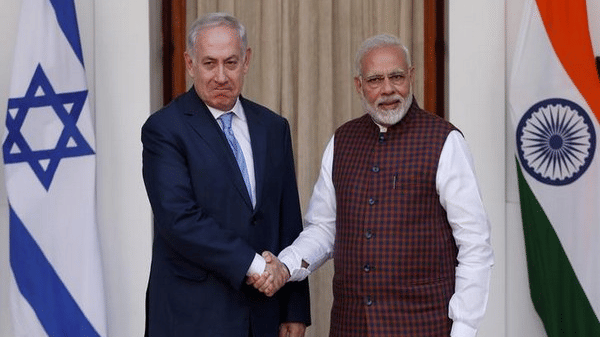Thank you dear subscribers, we are overwhelmed with your response.
Your Turn is a unique section from ThePrint featuring points of view from its subscribers. If you are a subscriber, have a point of view, please send it to us. If not, do subscribe here: https://theprint.in/subscribe/
India’s primary interests in the Middle East are pragmatic and focused on economic and strategic partnerships rather than military entanglements. Initiatives such as I2U2—linking India, Israel, the United Arab Emirates, and the United States—and the India–Middle East–Europe Corridor (IMEC) exemplify India’s forward-looking approach. These projects are designed to enhance trade, energy connectivity, and regional development, creating corridors that link Asia, the Middle East, and Europe. Both initiatives, however, are contingent on a degree of regional stability that remains elusive. The ongoing conflicts involving Israel, Gaza, Iran, and Iraq highlight the fragility of the geopolitical environment, making it clear that India’s ambitions cannot be realized by taking sides or becoming embroiled in local disputes.
The Gaza crisis exemplifies the complex dynamics of the Middle East. Israel, asserting its right to exist and defend its sovereignty, has carried out military operations that have drawn international criticism. While the humanitarian consequences are real, the scale of the criticism often ignores the broader context, including the responsibilities of Hamas and other actors who perpetuate violence. Meanwhile, Palestinians remain in a state of prolonged suffering, and even countries that profess solidarity—such as Iran or certain Arab states—have largely failed to convert rhetoric into effective action. India’s perspective, rooted in pragmatism, is that moral outrage alone cannot dictate policy; strategic engagement requires clarity about where India can influence outcomes and where restraint is wiser.
India’s approach to the Middle East is a model of strategic autonomy. By focusing on economic and infrastructural initiatives rather than military involvement, New Delhi positions itself as a neutral but indispensable partner. The I2U2 framework enables India to collaborate with technologically advanced nations like Israel and economically dynamic partners like the UAE, while strengthening its trade and energy security. Similarly, IMEC aims to create an alternative trade and logistics corridor linking India to Europe via the Middle East, reducing dependency on maritime chokepoints and providing resilience to global supply chains. Both initiatives demonstrate that India can achieve influence and growth without resorting to intervention in conflicts that others perpetuate.
Energy security is another critical dimension. India, as the world’s third-largest energy consumer, maintains deep economic ties with the Gulf states. By remaining disengaged from regional conflicts, India ensures uninterrupted access to energy supplies while simultaneously investing in renewable alternatives to reduce vulnerability. Its strategy balances immediate energy needs with long-term sustainability, reinforcing India’s reputation as a reliable partner in global energy markets.
The principle of strategic restraint extends to the ongoing war in Europe as well. India maintains relations with all major actors, avoiding alignment in a way that could compromise its economic or geopolitical interests. By refusing to be drawn into wars where it has no direct stakes, India preserves flexibility and credibility, which are invaluable in a multipolar world where alliances shift rapidly.
This disciplined approach contrasts sharply with the behavior of many Western powers, whose interventions in the Middle East and elsewhere have often been costly and counterproductive. The wars in Iraq, Syria, and more recently in Ukraine demonstrate the limits of military power and the consequences of overreach. India’s focus, by contrast, is on building soft and structural power—through trade, technology partnerships, energy security, and diplomatic influence—rather than through entanglement in conflicts that it cannot control.
Furthermore, India’s strategy is forward-looking in its use of multilateralism. By leveraging platforms like I2U2 and IMEC, India positions itself as a hub for trade, technology, and connectivity in the region. These initiatives enhance India’s influence without generating the political and humanitarian costs associated with interventionist policies. They also allow India to deepen relationships with multiple partners simultaneously, creating networks of mutual interest that strengthen its global leverage.
In the Gaza context, India’s stance demonstrates a careful balance between principle and pragmatism. While recognizing the humanitarian consequences of conflict, India avoids taking sides in ways that could compromise its broader interests. This measured position enables New Delhi to maintain relationships with Israel, Arab states, and Iran simultaneously, all of which are critical for trade, energy, and regional stability. By prioritizing long-term growth and connectivity over short-term moral signaling, India ensures that it remains a central player in a region where volatility is the norm.
In conclusion, India’s strategic approach in the Middle East and Europe reflects a clear-eyed understanding of both opportunity and risk. By focusing on initiatives like I2U2 and IMEC, India can expand trade, energy, and infrastructure influence while maintaining neutrality in conflicts that others perpetuate. Its measured restraint in Gaza and Europe ensures that India’s rise is not derailed by wars it cannot control. In a multipolar world defined by both volatility and opportunity, India’s combination of pragmatism, foresight, and strategic autonomy positions it to benefit from the evolving geopolitical landscape without unnecessary entanglement in the wars of others.
Col KL Viswanathan
(The author is an Indian Army veteran and a contemporary affairs commentator. The views are personal. He can be reached at kl.viswanathan@gmail.com )
These pieces are being published as they have been received – they have not been edited/fact-checked by ThePrint.


